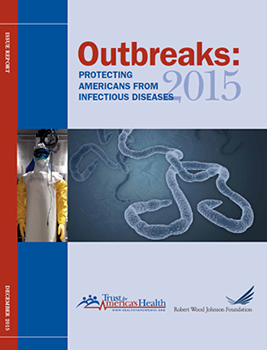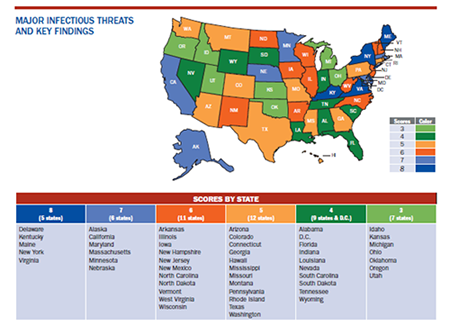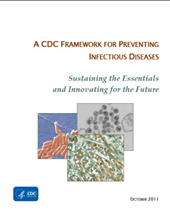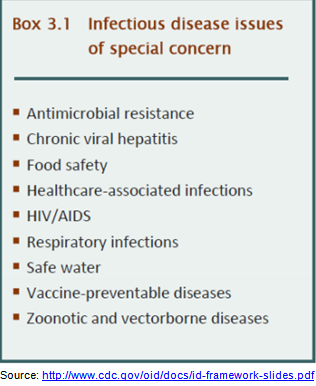Online Course
NRSG 780 - Health Promotion and Population Health
Module 11: Infectious Diseases
Population-based Initiatives to Reduce Infectious Diseases
National Programs

The Robert Wood Johnson Foundation and The Trust for America’s Health landmark and latest report entitled Outbreaks: Protecting Americans from Infectious Diseases 2015 emphasizes that fighting infectious disease requires constant vigilance and tools to control ongoing outbreaks, detect new and reemerging outbreaks and monitor for potential bioterrorist threats. The report highlights the following major infectious threats:
- Superbugs
- Middle East Respiratory Syndrome
- Foodborne Illnesses
- HIV/AIDS and Viral Hepatitis
- Healthcare-associated Infections
- Influenza (The Flu)
- Global Public Health Capacity
For more information, review the required reading (pp. 4-10) available at https://www.issuelab.org/resources/23703/23703.pdf
The report ranks the states on the ten following indicators with zero being the lowest possible score and ten the highest:
- Public Health Funding
- Flu Vaccination Rates
- Childhood Immunization School Requirement Policies
- HIV/AIDS Surveillance
- Syringe Exchange Programs
- Climate Change and Infectious Disease
- Central Line-associated Bloodstream Infections
- Public Health Laboratories with Biosafety Professionals
- Public Health Laboratories that Provide Biosafety Training
- Food Safety
Scores ranged from 8 (best) in Delaware, Kentucky, Maine, New York and Virginia to - 3 (worst) in Idaho, Kansas, Michigan, Ohio, Oklahoma, Oregon and Utah.

Source:http://healthyamericans.org/assets/files/TFAH-2015-OutbreaksRpt-FINAL.pdf
 The CDC Framework for Preventing Infectious Diseases is the U.S. guide for improving the country’s ability to prevent known infectious diseases and to recognize and control rare, highly dangerous and emerging infectious diseases.
The CDC Framework for Preventing Infectious Diseases is the U.S. guide for improving the country’s ability to prevent known infectious diseases and to recognize and control rare, highly dangerous and emerging infectious diseases.
The framework targets three essential elements:
- Strengthen public health fundamentals including infectious disease surveillance, laboratory detection and epidemiological investigation
- Identify and implement high-impact public health interventions to reduce infectious disease.
- Develop and advance policies to prevent, detect and control infectious diseases
The framework highlights nine diseases:

National Notifiable Disease Surveillance System (NNDSS)
The CDC maintains the National Notifiable Disease Surveillance System, based on voluntary reporting of infectious and non-infectious diseases and outbreaks from 57 states and territories. The NNDSS facilitates the sharing of health information to monitor, control and prevent the occurrence and spread of state-reportable and nationally notifiable diseases and conditions. It is also used to improve and standardize public health surveillance systems for state and local health departments as well as with health information technology systems used by hospitals, laboratories and private providers.
Statewide Programs
The Maryland Department of Health’s infectious disease efforts are housed within the Prevention and Health Promotion Administration.
The Maryland Department of Health’s Infectious Disease Bureau includes specific centers that focus on the following:
- Vaccine-Preventable Diseases
- Zoonotic and Vector-borne Diseases
- Adult Viral Hepatitis Prevention
- Sexually Transmitted Infections Prevention
- Human Immunodeficiency Virus Prevention
- Human Immunodeficiency Virus Care Services
- Tuberculosis Control
Reportable Diseases
The Maryland Department of Health also maintains the registry of diseases, conditions, outbreaks and unusual manifestations that are reportable under the Code of Maryland Regulations (COMAR) 10.06.01.03 C. These regulations stipulate what conditions should be reported, who should report, primarily health care providers and laboratories, how reporting should occur, where reports are sent, important time lines and when laboratories should submit specimens to the state public health laboratory.
Reporting cases of known or suspected infectious diseases protects the public's health by ensuring the proper identification and follow-up of cases. Public health workers at both local and state levels follow individual cases to ensure proper treatment, identify potential sources of infection, provide education to reduce the risk of transmission, identify susceptible contacts and take other measures aimed at reducing the spread of disease. Analysis of data across all cases helps to monitor the impact of those conditions, measure trends, identify areas of risk, detect outbreaks, monitor control efforts and allocate resources effectively.
Take a few minutes to review information on reportable diseases in Maryland at https://phpa.health.maryland.gov/Pages/reportable-diseases.aspx.
Click here for more information on Maryland Department of Health's Infectious Disease Bureau.
This website is maintained by the University of Maryland School of Nursing (UMSON) Office of Learning Technologies. The UMSON logo and all other contents of this website are the sole property of UMSON and may not be used for any purpose without prior written consent. Links to other websites do not constitute or imply an endorsement of those sites, their content, or their products and services. Please send comments, corrections, and link improvements to nrsonline@umaryland.edu.